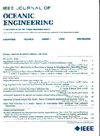Underwater Image Enhancement via Piecewise Colour Balancing and Multiscale Enhancement Fusion
IF 5.3
2区 工程技术
Q1 ENGINEERING, CIVIL
引用次数: 0
Abstract
Underwater images often suffer from multiple degradation issues, such as color casting, low contrast levels, and blurry details, which limits the applicability of underwater images in ocean exploration tasks. An underwater image enhancement method implemented via piecewise color balancing and pyramid-based contrast enhancement (PBPE) is proposed in this article. Concretely, PBPE first uses a reference channel with the maximum mean and two gain factors to balance the differences among the r, g, and b channels. PBPE presents a pixelwise transmission estimation method that is based on the mapping between the transmission and the backscattered light. Specifically, an adaptive compensation strategy is proposed to adaptively refine the transmission. Finally, PBPE captures a detail pyramid via multiscale Gaussian decomposition and uses the estimated transmission to remove haze and increase the degree of detail, thereby enhancing the overall contrast level of the underwater image. Comprehensive experiments conducted on two underwater image enhancement data sets indicate that our PBPE approach achieves better results and outperforms the state-of-the-art methods; i.e., compared with those of the second-best method, the average blur and density of the fog assessment-based defogger values of our method decrease by at least 2.67% and 4.55%, respectively, which shows that our method achieves enhancement results with high contrast levels and natural appearances.基于分段色彩平衡和多尺度增强融合的水下图像增强
水下图像通常存在多种退化问题,如偏色、对比度低、细节模糊等,限制了水下图像在海洋勘探任务中的适用性。提出了一种基于分段色彩平衡和基于金字塔的对比度增强(PBPE)的水下图像增强方法。具体来说,PBPE首先使用一个具有最大平均值和两个增益因子的参考信道来平衡r、g和b信道之间的差异。PBPE提出了一种基于传输与背散射光之间映射关系的像素级传输估计方法。具体来说,提出了一种自适应补偿策略来自适应地改进传输。最后,PBPE通过多尺度高斯分解捕获细节金字塔,并利用估计的透射率去除雾霾,增加细节程度,从而提高水下图像的整体对比度水平。在两个水下图像增强数据集上进行的综合实验表明,我们的PBPE方法取得了更好的效果,优于现有的方法;即,与次优方法相比,我们的方法基于雾评估的去雾器值的平均模糊值和密度值分别降低了至少2.67%和4.55%,这表明我们的方法达到了高对比度和自然外观的增强效果。
本文章由计算机程序翻译,如有差异,请以英文原文为准。
求助全文
约1分钟内获得全文
求助全文
来源期刊

IEEE Journal of Oceanic Engineering
工程技术-工程:大洋
CiteScore
9.60
自引率
12.20%
发文量
86
审稿时长
12 months
期刊介绍:
The IEEE Journal of Oceanic Engineering (ISSN 0364-9059) is the online-only quarterly publication of the IEEE Oceanic Engineering Society (IEEE OES). The scope of the Journal is the field of interest of the IEEE OES, which encompasses all aspects of science, engineering, and technology that address research, development, and operations pertaining to all bodies of water. This includes the creation of new capabilities and technologies from concept design through prototypes, testing, and operational systems to sense, explore, understand, develop, use, and responsibly manage natural resources.
 求助内容:
求助内容: 应助结果提醒方式:
应助结果提醒方式:


